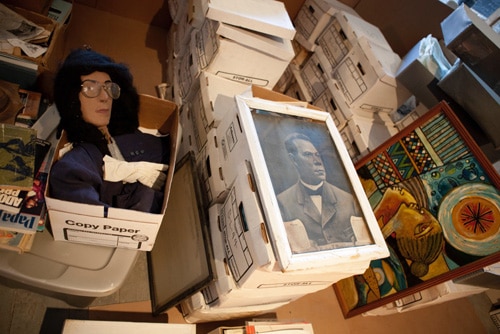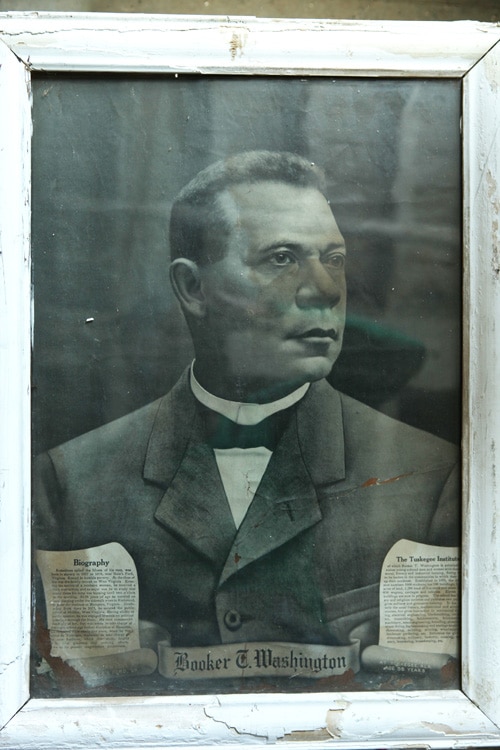Fallen Fruit of OMAHA! at BEMIS opens August 6th
Power Of People, Power Of Place
-Fallen Fruit (David Burns and Austin Young)

We find meaning in the things we take with us. When we move to another apartment, city, state, country, or continent, we bring objects with us; letters, books, photographs, works of art, heirlooms, tchotchkes and seemingly random things to remind us of who we are as a culture, a family, and as an individual. In time, when these objects are left behind and rediscovered – they can they tell intimate stories about people and place. Perhaps if we let go of all of these familiar things, we would lose our identity and instead merge with the existing culture of the land. -Fallen Fruit
LOS ANGELES-BASED COLLECTIVE FALLEN FRUIT EXPLORES OMAHA HISTORY AT BEMIS CENTER
July 12, 2015, Omaha, NE — Bemis Center for Contemporary Arts presents Power of People, Power of Place, an exhibition project with Los Angeles–based art collaborative Fallen Fruit (David Burns and Austin Young). On view August 6 to October 10, an opening reception will be held on Thursday, August 6 from 7pm to 9pm. Prior to the opening reception, Fallen Fruit will participate in Bemis Center’s monthly Art Talk program where they will discuss their research and installation process.
Power of People, Power of Place is the latest in Fallen Fruit’s ongoing series of projects that use fruit as a material to investigate culture and explore social engagement. The concept for this project was inspired by a part of the Great Plains Black History Museum collection that is being temporarily stored on the fourth floor of Bemis Center. During a research trip to Omaha in April of 2015, Fallen Fruit began to mine this collection. “As we opened boxes, some of them molded from years of dampness, the objects began to construct a complex picture about the things we leave behind,” said Fallen Fruit. “In time, the objects that once held meaning to us are rediscovered by others, telling them intimate stories about people and place.”
Continuing their research, Fallen Fruit visited other collections and archives in Omaha, including the Joslyn Museum, El Museo Latino, The Schrager Collection, and Omaha Public Library. Burns and Young have borrowed a range of objects from these and other Omaha collections and archives and arranged them into an exhibition that creates an installation artwork that becomes a portrait of the city of Omaha.
Fallen Fruit’s eclectic mix of borrowed books, letters, tchotchkes, domestic objects, and works of art (including pieces from Bemis Center’s own collection of artworks by past artists-in-residence) is assembled against the backdrop of their signature fruit themed wallpaper. For each exhibition project, Burns and Young design a custom wallpaper featuring fruit(s) specific to the location. Here, the artists take the apple as their focus, probing its rich symbolism and regional provenance, dating back to the Oregon Trail. “In the scope of our work, we have discovered that culture as well as fruit moves around the world with people,” said the artists. “Inspired by the AppleJack Festival we learned that apples were planted during western expansion because they are easy to store in winter and grow naturally all across the United States without much care.”

Items from the Great Plains Black History Museum- photograph by Fallen Fruit
Burns and Young draw on an excerpt from the January 1877 issue of Nebraska Farmer:
“Now, in comparing Nebraska apples with the products of other states, their superiority was evident in at least three particulars. First, their flavor was superior. Apples from regions that were comparatively insipid, when grown in Nebraska, were found to be finely flavored. This was the case with all the samples tested. Second, the color was superior. This was observed by everyone who visited the Nebraska department, and every one who had an eye for the beautiful had a word of praise for these fine apples. Third, the Nebraska apples were exceptionally free from parasitic fungous growths. All the apples from other states that I examined, including those from Canada, were more or less affected by fungi.”
To complement the exhibition Bemis Center has partnered with Joslyn’s Kent Bellows Mentoring Program to realize Urban Fruit Trails, Fallen Fruit’s decentralized public planting project that includes sites in various cities around the world. Kent Bellows students, who represent various Omaha high schools and zip codes, will plant apple trees throughout the city, in effect creating “a walkable network of fruit trails” that can be shared and enjoyed by anyone. “We hope these youth develop a long-term relationship to art in their city by virtue of seeing their participation reflected in the landscape for years to come,” says Nicole J. Caruth, Bemis Center’s new Artistic Director for Exhibitions and Public Engagement.
Caruth counts community building as another goal of the project. “As a recent transplant to Omaha I’m struck by the segregation here,” she said. “Urban Fruit Trails emphasizes sharing and connecting rather than divisions, and it’s a wonderful example of the role that contemporary artists can play in breaking down barriers, or at least in facilitating a shift in how we think about boundaries.”
Burns and Young will work with Kent Bellows Studio students to plant trees on the Bemis grounds in August. The students will complete the plantings in October 2015, in conjunction with a special Bemis Center Open House/Open Studios event, and the organization’s first ever themed residency on the future food production and consumption.

from the Great Plains Black History Museum- photograph by Fallen Fruit
About the Artists
Fallen Fruit is an art collaboration originally conceived in 2004 by David Burns, Matias Viegener, and Austin Young. Since 2013, David Burns and Austin Young have continued the collaborative work.
Fallen Fruit began in Los Angeles with creating maps of public fruit: the fruit trees growing on or over public property. Fallen Fruit uses cartography and geography as an indexical platform to generate serialized and site-specific works of art that often embrace public participation. The work of Fallen Fruit includes photographic portraits, experimental documentary videos, public art installations, and curatorial projects. Using fruit as a method of reframing the familiar, Fallen Fruit investigates urban space, ideas of neighborhood, and new forms of citizenship. From protests to proposals for new urban green space, Fallen Fruit’s work aims to reconfigure the relationship of sharing and explore understandings of public and private, as well as real world and real time. They consider fruit to be many things; it’s a subject and object at the same time it is aesthetic. Fruit often triggers a childhood memory; it’s emotional and familiar. Everyone is an expert on the flavor of a banana. Much of this work is linked to ideas of place and family, and much of these works echo a sense of connectedness with something very primal—our capacity to share with others. Fallen Fruit uses fruit as a common denominator to change the way you see the world.
Power of People, Power of Place and Urban Fruit Trails are presented in part by generous support from Lincoln Financial Foundation.
About Bemis Center for Contemporary Arts
The mission of the Bemis Center for Contemporary Arts is to provide residency opportunities to artists from around the world, so that they may develop new ideas, expand their practice and engage the community. Bemis Center has been recognized as one of the “Top 10 residencies around the globe” by ArtInfo, and Jane Alexander, the former head of the National Endowment for the Arts, has called the Bemis Center “one of the great treasures of its kind in the country.”
Bemis Online
Website: http://www.bemiscenter.org
Facebook: http://www.facebook.com/bemiscenter
Twitter: http://www.twitter.com/bemiscenter
Instagram: http://www.instagram.com/bemiscenter
Fallen Fruit Online
Website: https://fallenfruit.org
Facebook: http://www.facebook.com/fallenfruit
Twitter: http://www.twitter.com/fallenfruit
Instagram: http://www.instagram.com/fallen_fruit
Bemis Center for Contemporary Arts
724 South 12th Street
Omaha, NE 68102
12th and Leavenworth
Admission and Parking: FREE
Phone: 402.341.7130
Fax: 402.341.9791
info@bemiscenter.org
Hours: Wednesday – Saturday 11:00 a.m. – 5:00 p.m.
